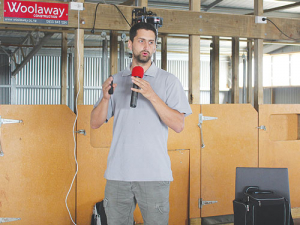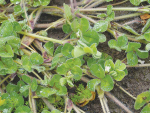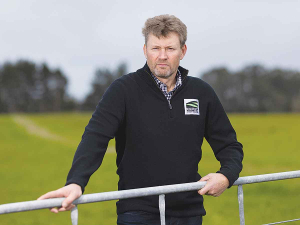Ageing pregnancy in beef herds has advantages including pasture management, easier mob management and a more uniform crop of calves, says Dr David Moors, Franklin Vets.
It makes it easier to monitor calving groups, he told a Beef + Lamb NZ Farming for Profit field day in northern Waikato recently.
“You don’t need to monitor late calving ones, you just do a quick whip round and focus on the early ones.
“You are less likely to over-feed those late calving ones than when they are all in the same mob. The late calving ones aren’t going to be over-fat so you will not have problems calving them.”
The biggest risk of disease to a calf is older calves.
“So if you are calving them in mobs of three weeks – early, mids and lates -- the oldest calf in that group will be three weeks and the youngest will be one week.
“So you will not have a one-week-old next to a nine- or even 12-week-old calf.
“They are less likely to get sick and you will have a more uniform crop of animals at the end of it.”
There is an 8-10 week period of anoestrus (non cycling) after calving. In the late ones it may be slightly shorter, but in theory you don’t want to maintain your late calving heifers, he says.
They may have one or two shots at mating; “you’ve got to carry them all though for the year, you’ve got rearing costs and then they will fall off the back, particularly in that nine weeks of mating”.
A study published in 2013 of 16,5000 animals in the US over 20 years showed what happens if you pick your heifer replacements only from those which calve in the first cycle, say, the first 21 days.
As a heifer they give birth to lighter calves but the weaning weights of the calves from heifers in the first cycle are heavier. Those heifers also remained in the herd one year longer than their counterparts.
After five years 40% of your heifers from the first cycle are retained. With second- and third-cycle heifers only about 20% are still in the herd.
“So after five years you’ve got twice as many heifers retained in your herd, which means you’ve got more options.
“They give birth two-four days earlier for the second to fourth calf which… doesn’t ring true that all this effect is just from them getting in calf earlier.
“These heifers are superior in their genetics. They probably suit your system a lot better and their weaning weights for their first six calves equate to weaning an extra calf.”
So for the first six calves there’s about a 70kg difference in weight between those from an animal that calved in the first cycle versus animals that calve in the third. So there is a big gain to be made.
“You’ve got to be hitting your heifer targets for mating before you think about doing this,” he says. If you are not hitting those, you are not going to get these heifers in the first cycle anyway.
He says you need to rear more heifers if you plan to stick to only keeping ones in the first cycle.
“So you basically need the number of replacements you want and you divide it by 0.7 and that gives you the number you need to put to the bull. “So for every seven of your replacements you need to be putting 100 to the bull.”
You still mate them for nine weeks to avoid any complications arising during mating.
“You pull out anything that has been in the first 21 days; anything else can be sold.
“Or if you have had any complication with mating, what we do is scan it and mark anything green that’s within the first 21 days and anything that is in the first two weeks of that second cycle, we write the number on the back with orange.
“If we don’t have enough numbers through, we can draft off some from the second cycle.
“With these animals you probably have the flexibility to sell them, but if not you can probably stick them on the feedlot and flick them off.”
It will take you about 10 sec/animal to age them rather than just a ‘yes’ or ‘no’. It costs about $1 more than just doing a ‘yes’ or ‘no’ at drafting. You can record them on paper but they tended to use three types of paint to mark the groups.
“Normally with yes/nos the bull will come out and you pregnancy test two-three months later. You want to be doing it about six weeks after the bulls have come out so you can get accurate dates on those pregnancies.
“In theory embryonic loss is great earlier in the pregnancy so you could end up with slightly more empty animals come calving time, but this doesn’t appear much of a problem.”
In retaining heifers which only calve in the first 21 days, you will have a higher attrition rate of what you put to the bull. But if you can sell them that is ideal, he says.
“You will keep your heifer in your herd for a year longer so you don’t have the wastage of heifers leaving the herd early.
“Ageing of pregnancies is only marginally more expensive and only takes a bit more time.”











